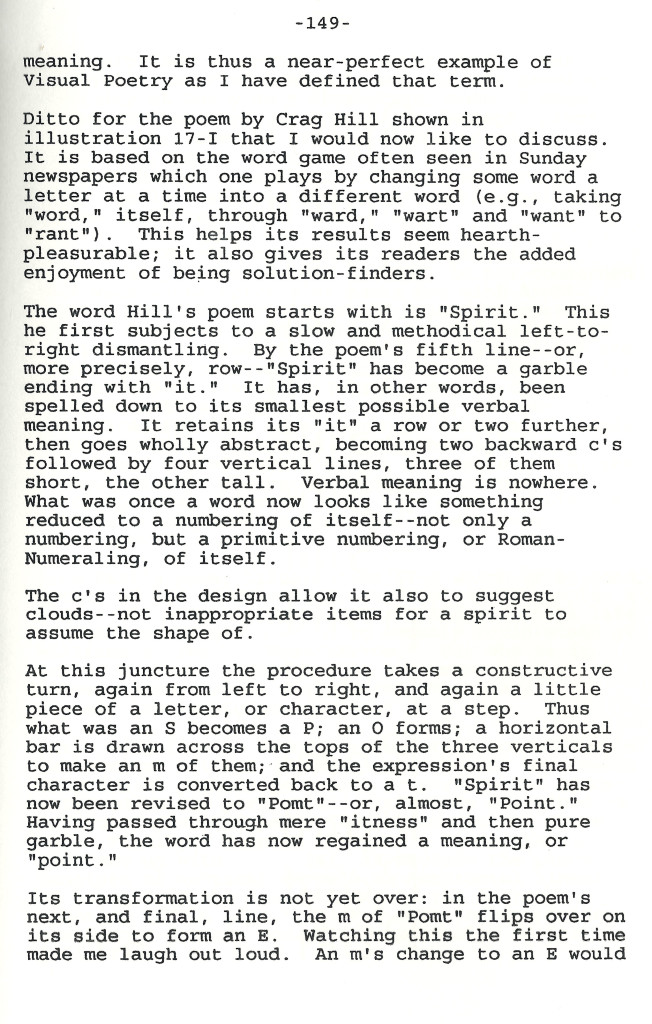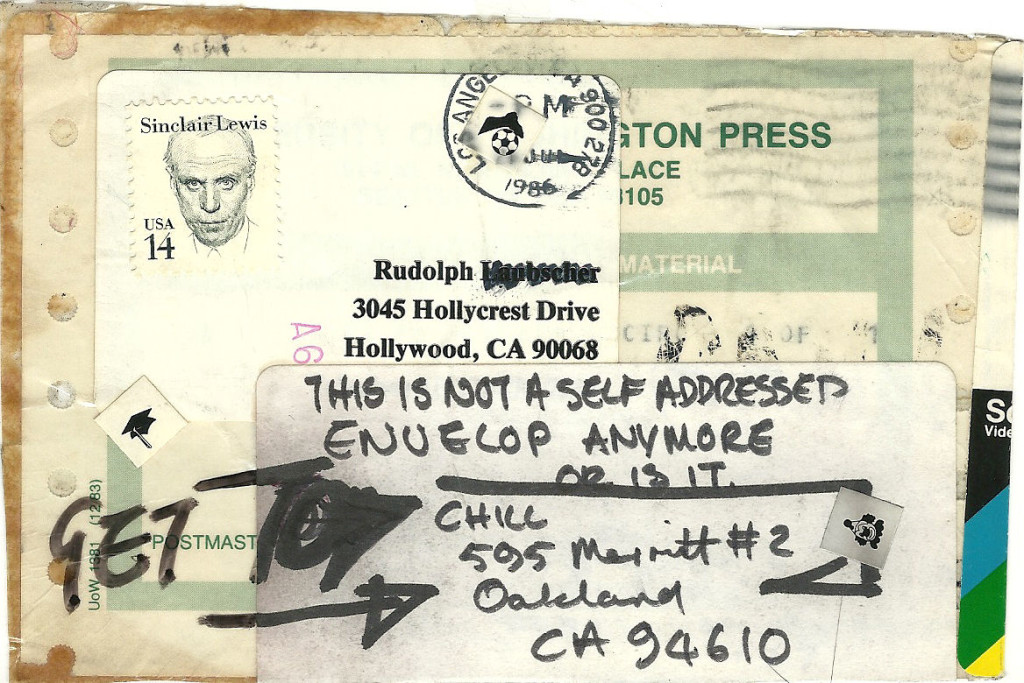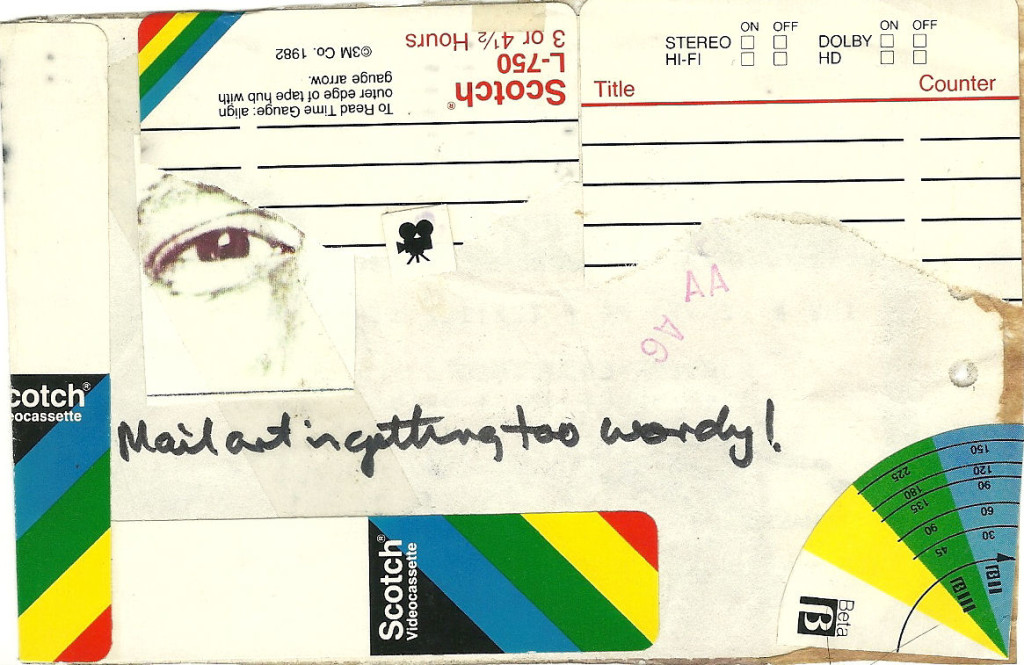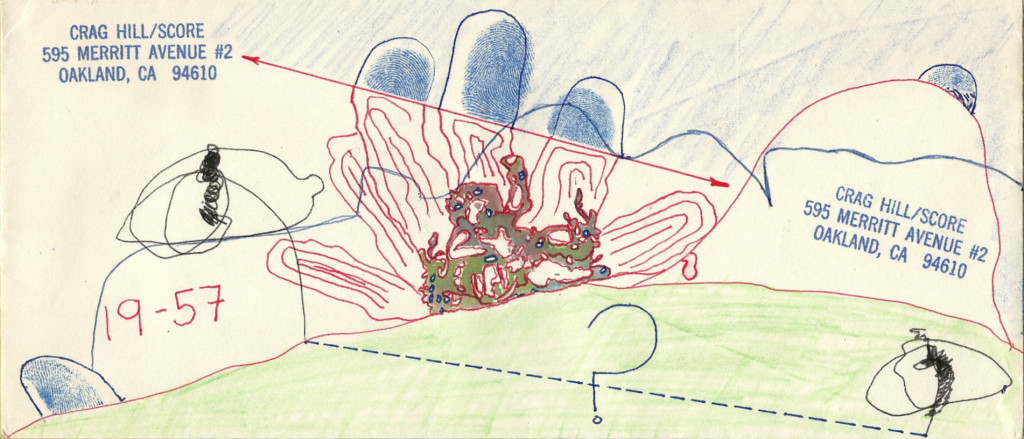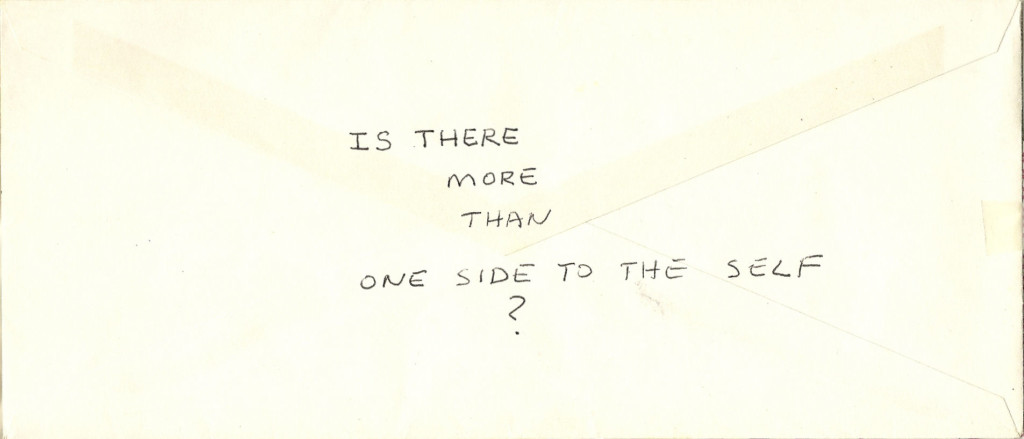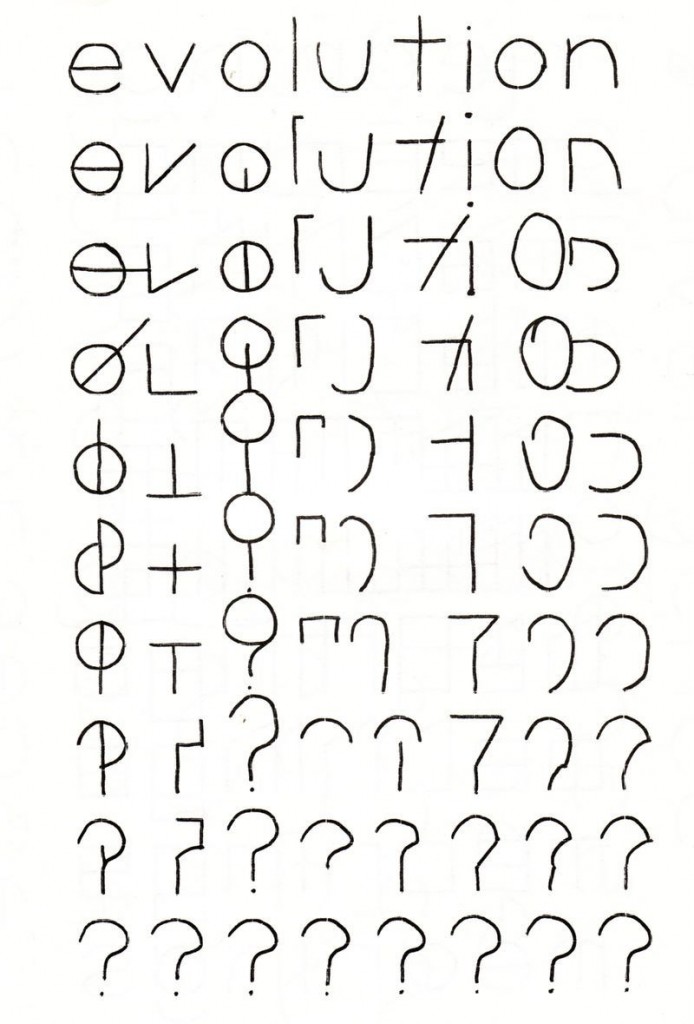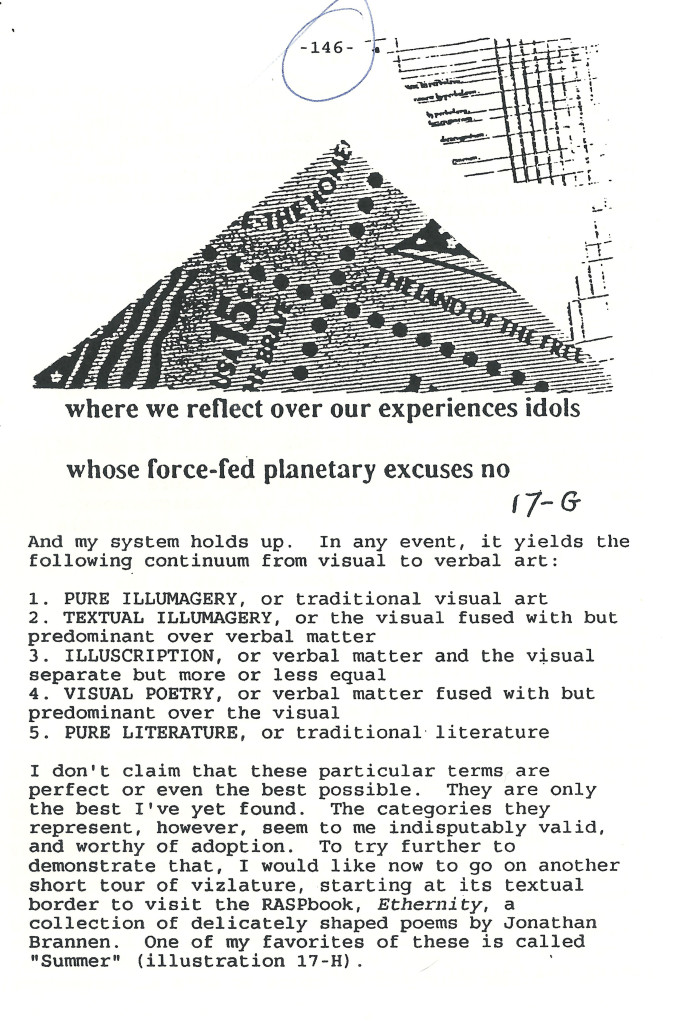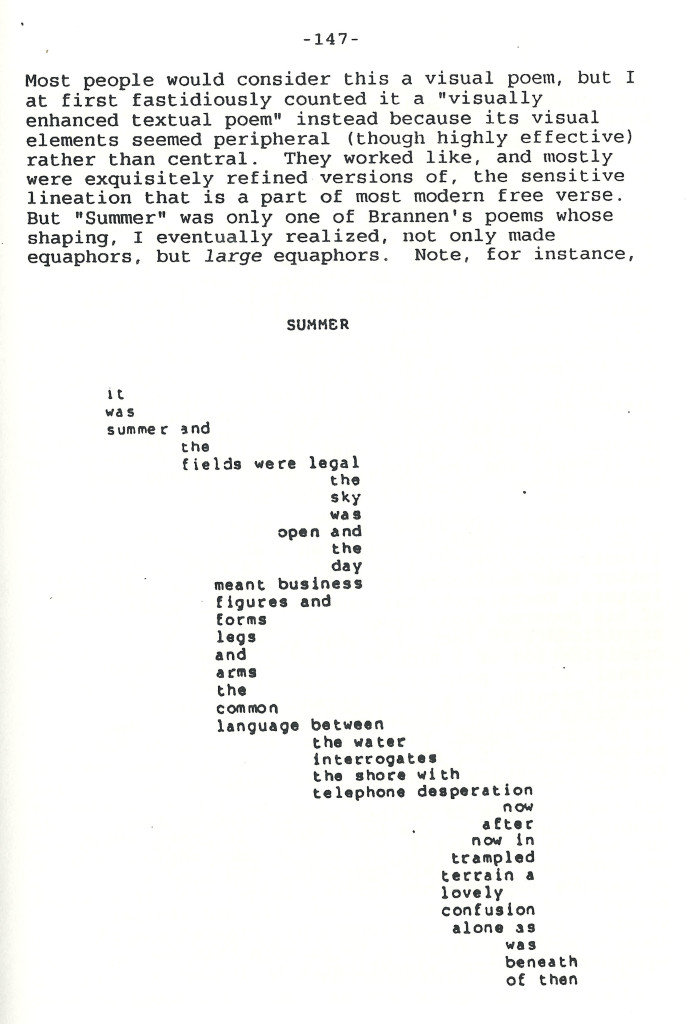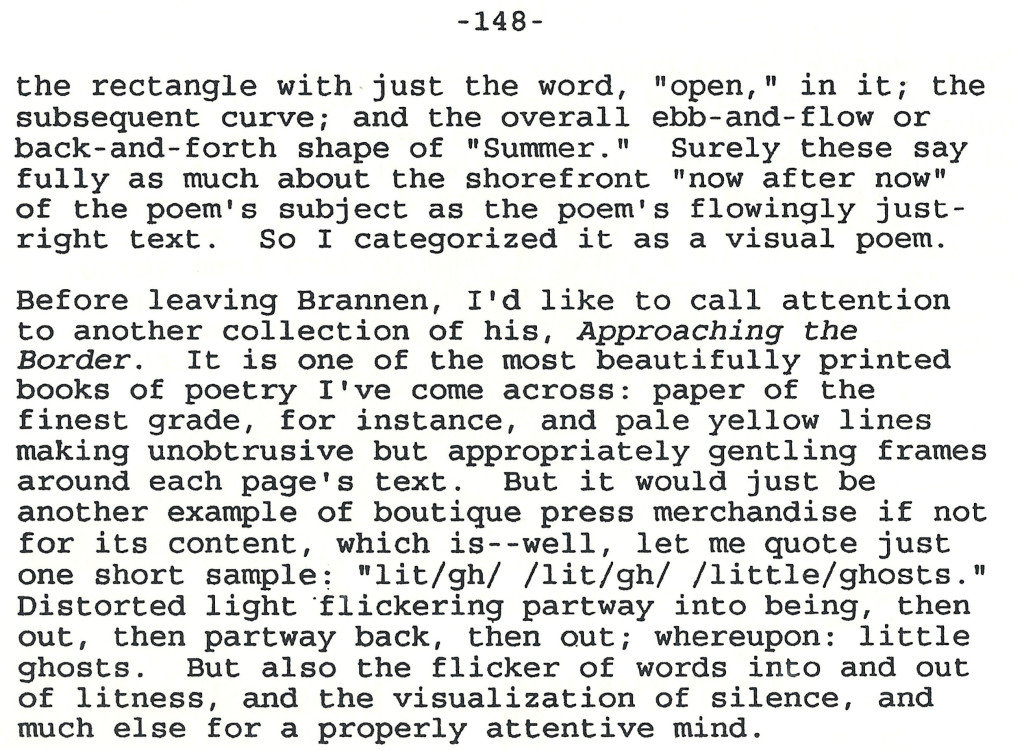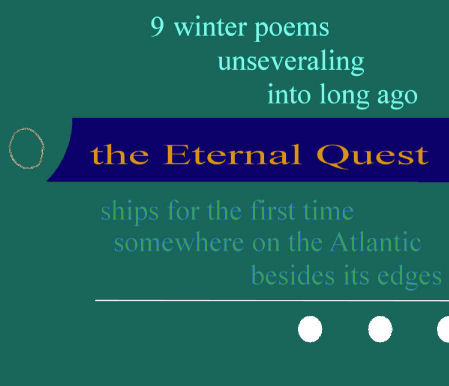Archive for the ‘Crag Hill’ Category
Entry 1345 — Excerpts from a Masterpiece
Sunday, January 19th, 2014
The masterpiece is my Of Manywhere-at-Once. I suddenly had the brilliant thought of taking care of blog entries for the next few days with full pages of the third edition of it (the Runaway Spoon Press, 1998–the first edition was published eight years earlier, with this section the same as it is here). For once, laziness is not my reason for doing this. What is, is a need to concentrate of an essay I’m working on whose deadline will soon be on me. So: here are three consecutive pages from my book, left as is:
I think I have one or two copies of my available for sale, but they are now collectors’ copies, so I have to ask for a hundred bucks for one. But I will sign it. Its buyer will also have the satisfaction of having helped a poet keep from bankruptcy. (I’m serious–otherstreamers ought to ask for compensation at least equal to a thousandth of what celebrated tenth-raters get for absolute crap. And what can we lose since we can’t get even the cost of our raw materials for anything?)
As I posted the second of my three pages, I thought to myself (as opposed to thinking to someone else–ain’t the Englush lingo funny at times?) I really ought to save my second and third pages for my next two entries. Being nice to my readers triumphed, though, so they are all here. I do plan to use them again tomorrow. I have second thoughts about at least one part of my text, and first thoughts about what I think about it, and what was going on in my life at the time I wrote it.
.
Entry 1233 — Rescued by an SASE
Friday, October 4th, 2013
I was in bed for the night just now (at nine, my usual bedtime), when I realized I hadn’t posted an blog entry for today! I’ve been very absent-minded since my surgical procedure on Monday. I hope that’s due to the anaesthesia I was given. In any case, thank goodness I still have contributions to the SASE mail art show Crag Hill sent me to draw on, such as this one from Crag himself, his second in the show:
.
Entry 1181 — An SASE by Crag Hill
Tuesday, August 13th, 2013
Here’s the SASE Crag Hill, who organized the project, had for it:
.
Entry 1004 — Back to “Evolution”
Monday, February 4th, 2013
I thought the following worth an attempt at an appreciation, so here it is again:
Actually, I may have only one thing to point out, something I would hope everyone would notice without my help: the way each of the letters of “evolution” evolves. Nine little narratives of some letter’s journey to . . . who knows where. But notice, too, some of the wonderfully clever twists Crag adds to some of the processes: such as the different ways the two o’s evolve, and, expecially, the way the one on the left takes bloats into a chain containing two clones of itself on the way to what it eventually becomes. Meanwhile, the other o is help on its way by the n–which it in turn helps.
Ah, but I’ve made a huge mistake, it seems to me. Because reading is generally from the top of a page down, I took this visualization of evolution to go from the top down. It makes much more sense to view it as beginning in uncertainty–as identical forms–and then changing upward.
I suppose it could go either way. I like it going up, though. No matter. I pronounce the poem a sure classic.
.
Entry 1003 — A Transform by Crag Hill
Sunday, February 3rd, 2013
(Note: I had this entry ready a day or more early, then forgot to click the “public” button. I do that all the time!)
The following is another piece from Score 9; it’s called “Evolution”:
It’s one of a series of similar pieces that Crag Hill was turning out some twenty years ago he called transforms. I made a few of them myself, but no one else that I know of has, which I think a shame. It’s an excellent form he came up with, one with all kinds of possibilities–especially now that color can be added. I often lament that too few new visual poets either stick with standard concrete poetry practices, like visual onomatopoeia (forming words that look like what they denote), or leave words entirely for textual designs they call “asemic poems.” They don’t do anything with forms like Crag’s, or my long divisions.
Of course, there are problems with doing so: fear of stealing someone else’s invention, or being seen to; fear of degrading it by using it badly; a silly belief that everything one does must be 100% “new” (however ridiculously impossible that would be); or because one needs to keep up with what’s fashionable in the field. I suppose, too, there are those who just don’t connect with transforms or long division poems. I really really wish a few young poets would start seriously making long division poems. One reason for that is that I strongly suspect I’d learn from them, and maybe do a lot more with my own long divisions than I have been.
.
Entry 387 — 2006 Discussion of a Poem by Crag Hill
Wednesday, February 23rd, 2011
Recently, I’ve been going through the files with the graphics but not the texts of entries I made to my previous blog in search of mathemaku of mine. I want to number them all, so need a complete list of them. I think I posted just about all of them to my blog. In any event, yesterday I brought up a file for an entry (Blog959) whose visits was recorded as close to 200. Rarely did my old entries get more than 20 visits. Curious to see what was in the blog, I then brought up the file that had its text, which I think worth quoting here:
17 September 2006: Among the many intriguing items at Crag Hill’s Poetry Scorecard is this found poem of Crag’s that he posted 3 September:
From Index of First Lines Selected Poems Charles Olson
. I come back to the geography of it,
. I don’t mean, just like that, to put down
. I have been an ability–a machine–up to
. I have had to learn the simplest things. I live underneath
. I looked up and saw
. Imbued / with the light
. I met Death–he was a sportsman–on Cole’s. In cold hell, in thicket, how
. In English the poetics became meubles–furniture–
. is a monstrance,
. I sing the tree is a heron. I sit here on a Sunday
. It’s so beautiful, life, goddamn death
. it was the west wind caught her up, asAmazing poem, this. I’m not a big fan of Olson’s, though I believe he is a major poet, and that some of his poems are A-1. Surely, these lines could only have been from a poet, though. I recognize one or two, but in this discussion will not look up any of them. (Oops, I realize I couldn’t look up very many of them; I do have The Maximus Poems, and several of my anthologies have poems by Olson, but I don’t have the Selected Poems.)
“I come back to the geography of it,”
Anyway, what a beginning, this return to some geography. Olson was probably only returning to a genuine geography, of the locale I feel he jabbered too much about, but here–dislocated by the line-break–“geography” can wing us to the terrain of all kinds of things, including the memory of a breakfast, banking procedures, 3 A.M., everything having a geography. Less surlogically, the word brings us to fundamentals, to the earth, to reality seen large, solid, inanimate . . .
What, I suddenly wonder, would the geography of geography be? Poems like this– effective jump-cut poems, that is–can flip us into such questions. Questions that resonate for the person flipped into them, I mean–as this one will surely not for everyone.
“I don’t mean, just like that, to put down”
Now a jump-cut leaving “geography” to simmer unconnected to any specific, and making the poem’s narrator more than a pronoun through his attempt to explain himself better. His explanation is broken off before getting anywhere, which effectually explains all the better his state of being at loose ends. A main interest is in whether he has just dropped one activity to return to the geography of whatever he’s involved in, and/or inadvertantly “put down” whatever he was doing because superficial or the like compared to geographical questions. “I have been an ability–a machine–up to”
The narrator continues trying to explain himself without finishing any of his ventures into self-analysis. I take this line to mean he’s not been personally/emotionally involved in whatever it is he’s talking about, “up to (now).” Note, by the way, how this line, with its pronounced metaphor, disturbs the quotidian tone of the previous (which, in turn, had demotically countered the academic tone of the first line).
“I have had to learn the simplest things”
Wow, no longer able (I guess) to let his machinery run his life without his involvement, the narrator has to concentrate, start from a sort of zero.
“I live underneath”
We’ve come to a new stanza. That the narrator says he lives underneath, which the lineation compels us to consider, rather than underneath something, opens a world for me. Certainly, we’re with a narrator deepening through himself (as we would expect from the poem’s consisting entirely of lines in the “i” section of an index).
“I looked up and saw”
This line seems planned to follow the one before it. This sudden strong logic out of the chaos of existence as if to reassure us that life does make sense is one of the virtues of found poetry. Again, a line-break re-locates us, in this case keeping us from a transitive verb’s object, compelling us to consider “saw” as an intransitive verb. The narrator has experienced illumination, not just seen some detail of ordinary life. No big deal if the context set us up for this sort of heightened seeing, but something of a (good) jolt in this zone of reduced context.
“Imbued / with the light”
Yikes, this sentence carries on trouble-free from the previous one.
“I met Death–he was a sportsman–on Cole’s”
The grammar now shatters the logic we seemed for a while to be in, just as “Death” shatters the text’s positive bright ambiance. I can’t help, by the way, thinking of Emily at this point. Death, however, is an absurd, trivial figure, some guy pursuing some conventional sport at some named who-cares-where.
“In cold hell, in thicket, how”
After the intrusion of a line with something of the effect of the famous porter scene in Macbeth, a new stanza, and high rhetoric electrifyingly bleakening the scene. Fascinating how “Cole” quickly colors into “cold hell,” by the way. “In English the poetics became meubles–furniture–”
Another weird shift–to the cold, densely thicketted geography of poetics (in English). “Furniture.” Something inanimate, stupid–but comfortable, for our convenience, to be used. . . . I don’t know the meaning of “meubles” but assume it’s some kind of furniture. Somehow, we are now in a man trying to explain himself in a geography/text trying to explain itself. At least, according to my way of appreciating language poems of this sort, which is partially to take them as exposures of mental states.
“is a monstrance,”
I guess we aren’t meant to sit on the chairs or put anything on the tables in the poem. We are definitely in a darkness and a confusion. “I sing the tree is a heron”
But the narrator can sing. He sings (presumably) of a tree’s resemblance to a heron. In other words, something dark (probably) and solid and motionless, like furniture, has something undark and capable of flight in it. Thus, the stanza ends hopefully, to set up the final one, which begins:
“I sit here on a Sunday”
The tone has gone quiet, conventional–but implicitly celebratory, Sunday being generally a day-off, and devoted to (generally happy) religious services. “It’s so beautiful, life, goddamn death”
The chaos of the poem is resolved with this line. The fragments we’ve been stumbling through, dark and light, are life–which is beautiful in spite of the presence of death.
“it was the west wind caught her up, as”
Because of the line before this one, I’m prepared to read this to be about a woman turned magically into a weightless angel the pleasant west wind is going to give a ride to. Chagall, at his undrippiest. I also read the awe of a man beholding a beautiful woman into the line. An image illustrating the climactic previous statement.
Okay, that was a preliminary once-through I hope some reader will get something out of. I did! Don’t know if I’ll return to it. Probably, so I can use it in a book. Don’t know if I’ll have anything better to say about it then, though.
* * * * *
I’m not ready to say more about the poem now–except that I wondered when I looked at my entry whether I’d mentioned the importance of Crag’s poem’s foundness when I discussed it. I saw I hadn’t. In my megalomaniacal opinion, I think I may be the only critic who has ever discussed the full aesthetic value of foundness. I did this in my discussion, possible two decades ago by now, of Doris Cross’s work–wonderful visual poems brought into being by painting or otherwise defacing, deleting, meddling with dictionary paintings. (I love Nietzsche not only for all he said, brilliantly, that I agree with, but for the megalomaniacal boasts he made about his accomplishments that have turned out to be valid.)
What I said in my Cross piece isn’t handy, so my comments now will probably be a bit incomplete and not as sharply expressed as what I said in it. First off, as anyone would agree and as many I’m sure have said, the quotations from Olson, add his life and writings to Crag’s poem. This is important. But what I think effective appropriation of found materials most importantly does is celebrate the essential logic of the universe. It reminds us that God is in his heaven allowing accidents to make affirmations–even for someone like I who doesn’t believe in God, and understands that accidents don’t really make affirmations, only happen so often that some of them, especially when a keen discoverer has an eye out for them, are bound to do what Crag’s collection does. Another, better way of putting it, is that we are reminded of who wonderfully well the human brain finds ways to give existence meanings, meanings that suggest Meaning.
Okay, not a view you’d think anyone would feel like a demigod for having, but it’s more than anyone else has said about foundness that I know of. And I can’t see how anyone could say it’s wrong.
.
. Poem Consults the Vseineur
.
. However seldom the vseineur
. said “universe” in Poem’s hearing,
. he accepted it,
. however clear it always was
. that it had misspoken.
.
